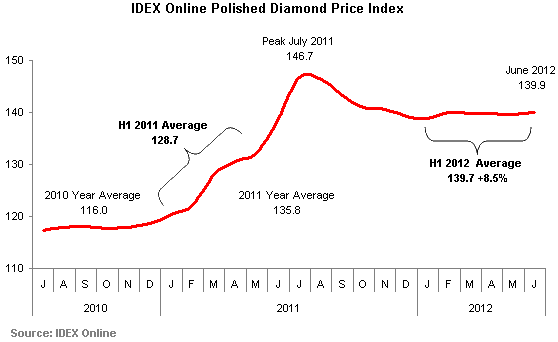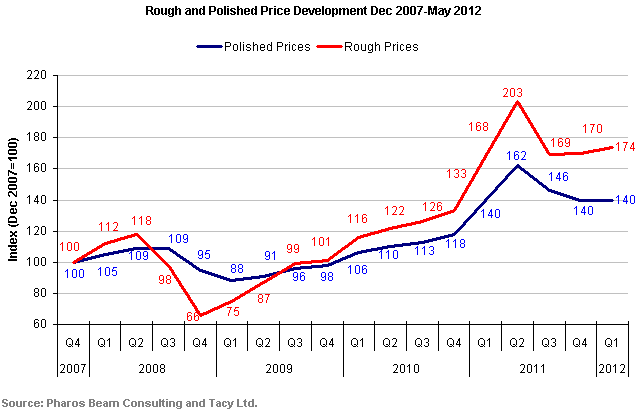Breaking the Concrete Floor
July 05, 12
A month ago, we published a column entitled “Fair Warning,” which focused on the problematic economic situation ahead. It mostly examined external economic changes, and their impact on the global diamond and jewelry industry. That column was written a few days after the closing of the JCK Las Vegas show. Following the show, about 80% of respondents to an IDEX Online poll on the subject stated that business was either “Good” or “OK.” Since then, matters have taken a turn for the worse.
We decided to keep the poll running longer than usual to gauge the long term-perspective of the show. The 20% that initially stated, “Business below the low expectations,” increased to 24% a week later.
In retrospect, fewer traders were happy with the results than it first appeared. Asking prices for polished diamonds also softened a little, a further indication that demand was not very good.
We closed that column, saying that the outcome of the
A more recent poll about demand for diamonds at the
We know one of the reasons for the slow trade is unfavorable external economic forces, but what about internal dynamics?
Prices Are High
Global polished diamond trade has declined in the past six months, down by about 10%, year-over-year. Manufacturing activity is also declining. Based on anecdotal data, we estimate that certification of diamonds is down nearly 10% and in the past month, trade has further declined.
If that is the case, why was the average price of diamonds in the first half of 2012 8.5% higher than in the first half of 2011? Prices in the first half of 2012 are at a plateau after they soared (and declined some) in the second half of 2011, as the following graph shows. This means that polished prices are rather high.

There is a reason for the high polished prices as well as a possible internal explanation for why retailers are not buying diamonds more frequently.
Rough prices are high, so high that manufacturers cannot afford to buy them. This is why rough prices at BHP Billiton, Alrosa and Diamdel, as well as suppliers of rough from Angola, are down 5% to 25% (!). And this is why De Beers agreed to allow Sightholders a further deferment in supplies. Sightholders can also turn down goods with impunity, giving them the ability to further restrict their purchases, if prices are too high. De Beers rarely decreases prices. But prices may need to come down even further.
This will ease some of the upward pressure on polished prices. A recent analysis by Chaim Even-Zohar and Pranay Narvekar found that prices of rough increased 74% between December 2007 and March 2012. This occurred while prices of polished increased only by 40%. The high rough prices created an impenetrable floor preventing polished prices from dipping further. Making matters worse, the price gap widened in the year prior to the second quarter of 2012.

Clearly, rough diamond prices need to come down. The concrete floor, hard and opaque, needs to be cracked.
However, what about retailers’ purchases? Conventional wisdom holds that despite the economic downturn, consumer spending continues. So why aren't retailers buying more? One possible explanation is that they see that wholesalers are under pressure and prefer to hold out. They also know that polished prices are high, although they may not understand why.
That is why they will replenish inventory only when and where necessary, but will not do more than that. They can tell that diamond wholesalers are sweating, and will wait, whenever they can, until prices decline before making any purchases.
We warned last month that the global economy was telling us to "expect matters to get worse." Now we can add that some of it is in the industry's hands. Prices – of rough and polished – are simply too high.
Follow me on Twitter
Get in touch on LinkedIn
Connect on Facebook
Or email me at edahn at idexonline dot com with any questions